Ancient Villages Protected : Nuclear Site Shields Archeological Finds
- Share via
RICHLAND, Wash. — Archeologists are starting to study Wanapum and Palouse villages up to 2,500 years old, as well as more modern non-Indian settlements, that have been preserved largely because of national security.
The 126 archeological sites--20 of them non-Indian--lie within the 570-square-mile Hanford reservation that makes fuel for nuclear weapons.
“It’s an irony that the protection offered Hanford because of its national defense role allowed these sites to be protected,” said James Chatters, who was hired last year as the first Hanford archeologist.
Once Home to 3,000
“The majority of archeological deposits throughout this region have been destroyed or covered by hydroelectric development, agricultural activities and domestic and industrial construction,” Chatters said as he crouched inside a stone hunting blind created by Indians thousands of years ago.
The heavy security that kept the public out of the sprawling federal plutonium production site for more than 40 years also preserved a collection of Indian villages, cemeteries and artifacts.
The arid Hanford site was once home to 3,000 Wanapum and Palouse Indians, who lived along the Columbia River, living on deer and salmon. They went to reservations and up to 2,000 whites moved in at the turn of the century. But the area remained largely empty until the government created the nuclear reservation in 1943 as part of the Manhattan Project.
Officials for Battelle’s Pacific Northwest Laboratories, which contracts most Hanford research, recently arranged the first press tour of archeological sites. Reporters were taken to the remains of a large Indian village and to the hunting blind, essentially a round stone hiding place built into the side of a canyon where hunters waited to kill passing deer.
They are among the most dramatic remains of 10,000 years of human activity in the area, said Chatters, who is developing a plan to manage and preserve the sites. “There are probably more intact archeological sites here than anywhere else in the United States. The majority of the sites don’t seem to have been disturbed.”
Perhaps the most important discovery was the site of a large Wanapum Indian village, which at one time had at least 60 housing sites and may have been occupied for 2,500 years, he said. It is one of the two largest in the Northwest, along with the Strawberry Island site at the mouth of the Snake River.
The village is now a series of circular depressions, overgrown with weeds, along with tool fragments, animal bones and other signs of human habitation.
The homes were pits dug into the ground and covered with wood and mat roofs, averaging 400 square feet and sheltering about a dozen people, Chatters said. There has been no excavation of the site yet.
Hanford was where the Wanapum prophet Smohalla held the first washat dance, which became central to the Washane religion still practiced by some Indians on the nearby Colville, Nez Perce, Umatilla, Warm Springs and Yakima Indian reservations, Chatters said.
But the same security that kept out looters also kept area tribes from sacred religious sites. Those restrictions have eased with the end of plutonium production, and negotiations are under way for more access.
Indians Not Thrilled
While part of Chatters’ job is advising the Department of Energy on Indian concerns, the tribes do not fully support his work. “We’re seen as gravediggers by the Indians,” he said.
Non-Indian sites include the former townships of White Bluffs, Hanford and Ringold, whose residents were turned out of their homes in the 1940s in an action paralleling the Indian relocation of a few decades earlier.
Also, Chatters said, the nine reactors that produced plutonium, including the material for the bomb that destroyed Nagasaki, are historic. The B Reactor, the first at Hanford, is being considered for preservation and development as a national historic site.
“Our purpose is not to judge the social or political merits of what we’re preserving,” Chatters said. “The reactor’s importance is much greater than the hunting blind’s, which fed a few families.”
More to Read
Sign up for Essential California
The most important California stories and recommendations in your inbox every morning.
You may occasionally receive promotional content from the Los Angeles Times.












